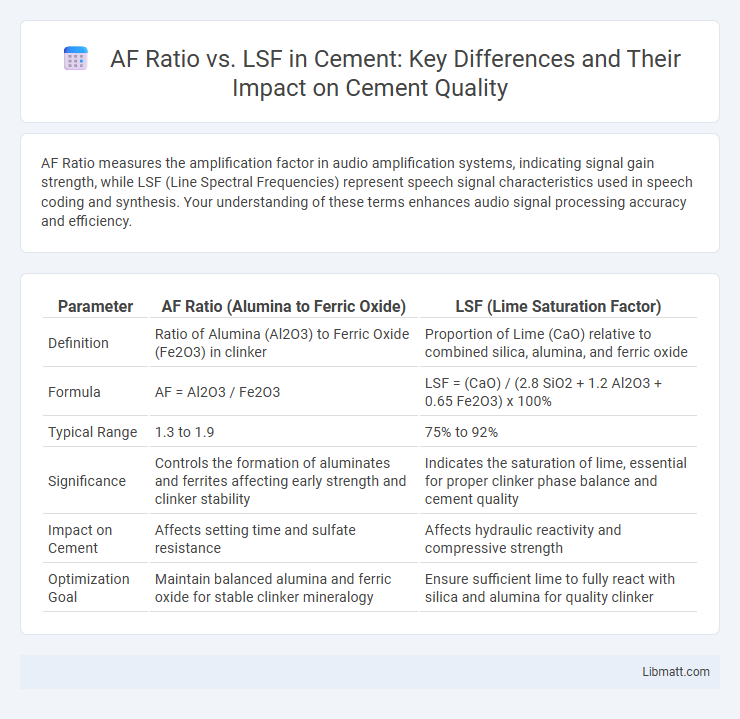AF Ratio measures the amplification factor in audio amplification systems, indicating signal gain strength, while LSF (Line Spectral Frequencies) represent speech signal characteristics used in speech coding and synthesis. Your understanding of these terms enhances audio signal processing accuracy and efficiency.
Table of Comparison
| Parameter | AF Ratio (Alumina to Ferric Oxide) | LSF (Lime Saturation Factor) |
|---|---|---|
| Definition | Ratio of Alumina (Al2O3) to Ferric Oxide (Fe2O3) in clinker | Proportion of Lime (CaO) relative to combined silica, alumina, and ferric oxide |
| Formula | AF = Al2O3 / Fe2O3 | LSF = (CaO) / (2.8 SiO2 + 1.2 Al2O3 + 0.65 Fe2O3) x 100% |
| Typical Range | 1.3 to 1.9 | 75% to 92% |
| Significance | Controls the formation of aluminates and ferrites affecting early strength and clinker stability | Indicates the saturation of lime, essential for proper clinker phase balance and cement quality |
| Impact on Cement | Affects setting time and sulfate resistance | Affects hydraulic reactivity and compressive strength |
| Optimization Goal | Maintain balanced alumina and ferric oxide for stable clinker mineralogy | Ensure sufficient lime to fully react with silica and alumina for quality clinker |
Understanding AF Ratio: Definition and Importance
AF Ratio, or Aperture-to-Focal-Length Ratio, measures the relationship between a lens's aperture diameter and its focal length, crucial for determining light-gathering ability and depth of field in photography. Understanding AF Ratio helps photographers optimize exposure settings and achieve desired image sharpness by controlling the amount of light entering the lens. Accurate knowledge of AF Ratio is essential for selecting lenses suited to specific shooting conditions and enhancing overall image quality.
What is LSF? Key Concepts Explained
LSF, or Line Spread Function, measures how an optical system responds to a line object, indicating its sharpness and resolution capabilities. Unlike AF Ratio, which quantifies autofocus performance, LSF directly assesses image quality by evaluating the system's ability to reproduce fine details. Your understanding of LSF helps in optimizing optical designs and improving image clarity in cameras and scanning devices.
The Role of AF Ratio in Various Industries
The AF Ratio plays a critical role in industries such as manufacturing, telecommunications, and finance by optimizing workflow efficiency and resource allocation. In manufacturing, the AF Ratio enhances production line accuracy and reduces waste, while in telecommunications, it improves signal processing and bandwidth management. Financial sectors utilize the AF Ratio for risk assessment and algorithmic trading strategies, demonstrating its versatility across different commercial applications.
How LSF Impacts System Performance
LSF (Line Spectral Frequencies) significantly impacts system performance by enhancing the stability and precision of speech signal representation, leading to improved compression and synthesis quality. Unlike AF Ratio (Autocorrelation Function Ratio), which primarily measures periodicity, LSF parameters provide robust spectral envelope modeling that reduces quantization errors and computational complexity. Optimizing LSF coefficients accelerates convergence in adaptive filters, directly boosting efficiency and accuracy in voice coding and recognition systems.
AF Ratio vs LSF: Core Differences
AF Ratio measures the amplification factor of a system, indicating how much a signal increases in strength, while LSF (Line Spectral Frequencies) represent frequency domain parameters used in speech coding and synthesis for stability and quantization efficiency. The core difference lies in AF Ratio being primarily an amplitude-based metric, whereas LSF focuses on spectral properties that help model and reproduce speech signals accurately. Understanding your system's requirements will guide whether AF Ratio or LSF is more relevant for signal processing and analysis.
Applications Where AF Ratio is Preferred
AF Ratio is preferred in applications requiring precise frequency stability and noise reduction, such as in radar systems, communication transmitters, and advanced signal processors. This metric effectively quantifies amplitude fluctuations relative to signal power, enabling accurate modulation and demodulation performance analysis. Your choice of AF Ratio ensures enhanced signal clarity and reliability in complex electronic systems.
Use Cases Best Suited for LSF
LSF (Load Sharing Facility) excels in managing large-scale, high-performance computing workloads by efficiently distributing computational tasks across multiple nodes, making it ideal for scientific simulations, financial modeling, and big data analytics. AF Ratio, which measures the efficiency of resource utilization, may indicate system performance but lacks LSF's robust scheduling capabilities needed for complex, parallel processing environments. Your organization benefits most from LSF when reliability, scalability, and workload prioritization are critical for mission-critical applications.
Comparative Analysis: Pros and Cons of AF Ratio and LSF
AF Ratio offers a precise measure of airflow efficiency, making it ideal for optimizing ventilation systems in industrial settings, while LSF excels in assessing sound frequency decay for acoustic analysis. Your choice between AF Ratio and LSF depends on whether airflow control or acoustic performance is the primary focus, with AF Ratio providing direct insights into air volume adjustments and LSF delivering detailed frequency-based sound assessments. Both methods present trade-offs: AF Ratio can be less effective in complex acoustic environments, whereas LSF may require more sophisticated equipment and analysis for accurate results.
Choosing the Right Metric: Factors to Consider
Choosing the right metric between AF Ratio and LSF depends on the specific analysis goals and data characteristics. AF Ratio is optimal for highlighting allele frequency differences across populations, providing insights into genetic diversity, while LSF (Local SNP Frequency) excels in detecting fine-scale local variations and linkage disequilibrium patterns. Consider factors such as population structure, resolution needs, and computational efficiency when selecting the most appropriate metric for genomic studies.
Future Trends in AF Ratio and LSF Optimization
Future trends in AF Ratio and LSF optimization emphasize advanced machine learning algorithms to enhance image clarity and processing speed. Integration of AI-driven models enables real-time adjustments, minimizing noise and maximizing spatial resolution in complex imaging systems. Emerging hardware accelerators will further support efficient AF Ratio and LSF computations for next-generation optical devices.
AF Ratio vs LSF Infographic

 libmatt.com
libmatt.com